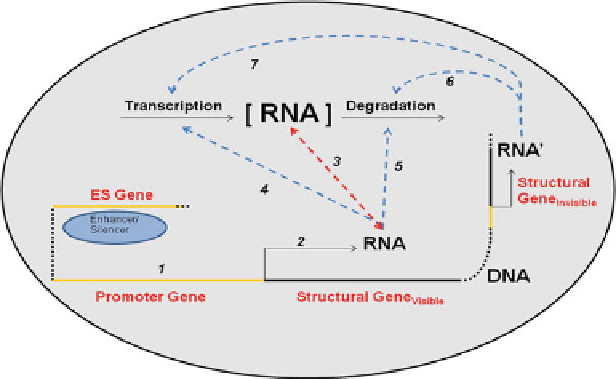Biology Reference
In-Depth Information
Fig. 12.22 The hypothesis that a DNA molecule itself is a gene consisting of two subtypes - (1)
the RNA-coding
structural genes
(see 2) and (2) the
regulatory genes
including promoters,
enhancers and silencers (see 1)
. Structural genes
act as templates for transcription (Step 4)
catalyzed by RNA polymerase or for replication catalyzed by DNA polymerase (not shown).
Regulatory genes, in conjunction with various transcription factors and ATP-driven molecular
motors (including DNA gyrase and topoisomerases), are postulated to control the
timing
of the
turning on or off of the expression of structural genes (Ji 1991), thereby contributing to the control
of the observed intracellular levels of RNA (indicated by the square brackets) (Step 3) which
result from the balance between
transcription
(4) and
transcript degradation
(5). It is convenient
to distinguish between “visible” genes encoding the “visible” RNA being measured or observed
and “invisible” or “hidden” genes encoding the “invisible” RNA molecules that affect the
levels of “visible” RNA molecules via regulating the
transcription
(see Step 7) and the
degrada-
tion
(Step 6) of visible RNAs. It should be noted that visible RNAs can also regulate the
levels of invisible RNAs (not shown) thereby indirectly regulating themselves via feedback (not
shown) (The figure was drawn with the assistance of my undergraduate student Julie Bianchini
in 2009)
In order for a d-gene (i.e., a gene acting as template for DNA replication) to be
able to regulate the activities of other genes through
cis
-mechanisms, it is necessary
for the d-gene to exert a mech7anical force on its target gene(s) in order to meet the
energy requirement for control (Hess 1975) and not to violate the laws of thermo-
dynamics. One possible source of the energy needed to generate such forces is the
conformational energy
stored in DNA duplexes introduced by ATP-dependent
enzymes such as DNA gyrases, variously called SIDDs (Benham 1992, 1996a, b)
and conformons (Ji 1974b, 2000) (see also Sect.
8.4
). Unlike protein molecular
machines that can transduce chemical energy into the mechanical energy or
conformons by their catalytic actions, d-genes cannot directly utilize chemical
energy to generate their mechanical forces due to lack of enzymic activity and
hence must rely on energy transfer from force-generating or conformon-generating

